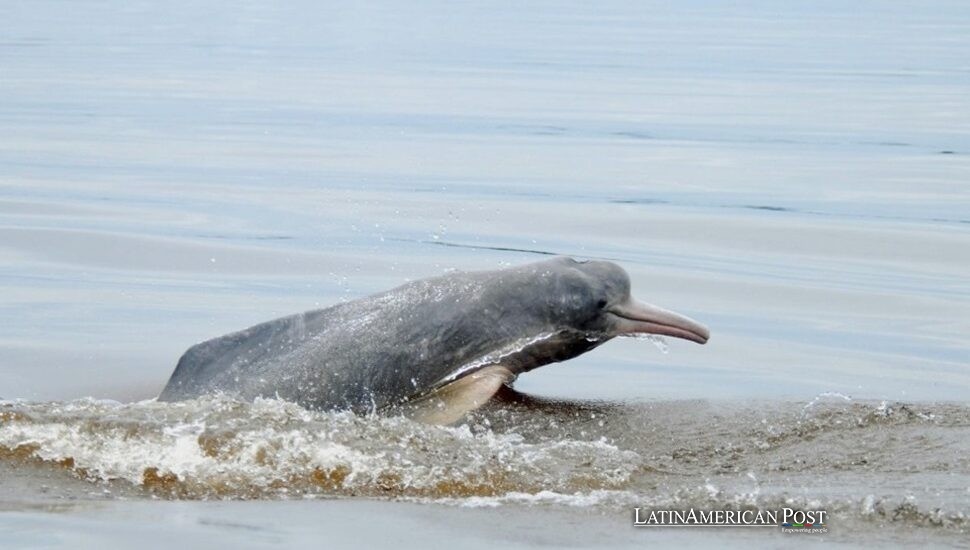Brazil's River Dolphins' Strange Peeing on Their Head Mystery

In the dim waters of Brazil’s Amazon habitat, river dolphins amaze researchers when they turn upside down to spray urine toward their heads. This odd act suggests complex social signals and reveals nature’s surprises in the Amazon.
Behavior Shaped By Intricate Social Lives
Brazil’s botos, known as Amazon river dolphins or pink river dolphins, live in the Amazon River network. These freshwater animals swim through twisted streams, dark waters, and floodplains full of hidden creatures – different from ocean dolphins. The local people told stories about the botos for hundreds of years. A mix of tales praised their smarts along with their charm. Some stories said these dolphins changed into humans after dark. Scientists focus on a more real puzzle about them. Researchers report that certain male botos engage in “aerial urination,” a behavior where they flip onto their backs, release a curved stream of urine into the air, and often let it land near their snouts. This unexpected and occasionally comedic display stands out among many wild animal interactions, prompting scientists to wonder why these pink-toned dolphins aim jets of pee overhead.
While animals have long used urine for signaling—like terrestrial mammals that deposit scents to demarcate territory or convey reproductive readiness—marine species rarely present apparent equivalents. In ocean or river habitats, watery surroundings quickly disperse chemical cues, making it tricky to glean how signals might persist or spread. Despite this, Amazon’s botos appear to have found a way to ensure that a chemical message remains accessible. Flipping belly-up and peeing into the air create a short but intense burst of concentrated fluid before it blends into the surrounding river. Another male often positions himself under the arc; snout extended as if striving to sniff or taste essential information in the urine.
Scientific inquiries into this spectacle reveal glimpses of the complex social interplay among male botos. Observers note that the peeing individual often swims belly-up in zigzag or circular patterns while another male “receiver” chases the airborne stream. The second male sometimes tries to position his rostrum—equipped with sensitive bristles—directly beneath the flow. The receiver might linger as though verifying chemical details as soon as the watery arc merges with the river surface. Only males have shown this behavior so far, prompting theories that the phenomenon might convey details about rank, physical prowess, or sexual availability. The bizarre spectacle underscores how certain species evolve unusual yet sophisticated communication strategies under unique ecological constraints.
New research analyzing these “aerial urination” episodes was published on January 31, 2025. While more studies are needed to decode precisely what secrets the urine holds, scientists theorize it may broadcast male quality or vigor. Through quick encounters, the male dolphins sense details about their competitors’ stress levels and health. Some researchers think the botos use their flexible snout bristles as receptors to detect chemical signals quickly. These sensitive hair-like structures help them navigate murky waters or find information trails.
Pink river dolphins of the Amazon have fascinated people for generations. A network of blood vessels and unique skin pigments creates their color, which grows more profound with age or stimulation. The local people respected these animals and created tales about clever beings that could change shape and walk the shores at dusk. However, the actual behaviors stayed hidden from researchers because cloudy waters made observation difficult. Recent studies revealed social patterns like group hunting or mating rituals. The newfound “aerial urination” now joins a growing list of surprising behaviors, adding dimension to our understanding of freshwater cetaceans.
Still, questions multiply. Do male botos exclusively use these arcs of urine for competitive bragging, or is it also a friendly bonding ritual? Might females also utilize urine signals in subtler contexts, even if they do not spray it overhead? Is this behavior more common when males compete for females in mating season? The reported cases came from the Tocantins River in central Brazil, which leads to questions of whether similar acts occur in other Amazonian rivers or whether this remains specific to these local groups. Researchers caution that short observation windows may mask the behavior’s complexity: incomplete data can distort how often or in what circumstances male dolphins “pee on their heads.”
For the scientists, the significance reaches beyond comedic effect. If botos employ advanced chemical communication, it underscores how illusions of a silent aquatic world are far from accurate. Smells and tastes, typically overshadowed in marine science by acoustic signals like echolocation or whistles, may play vital roles. Among land mammals, urine transmits a breadth of details, from fertility to territory ownership. The notion that Amazonian dolphins harness a parallel system in watery realms is logical and remarkable. Because the Amazon harbors swirling sediment and thick vegetation, visual cues alone might fail to cut through murky channels. A strong chemical cue could allow individuals to identify or track each other without needing a direct line of sight.
Exploring The Underwater Labyrinth
The Amazon River basin forms one of Earth’s most intricate water networks. Home to swirling blackwater tributaries, seasonal floodplains that expand dramatically during the rainy season, and thick canopies overhead, the environment fosters an array of specialized species. The botos, the largest freshwater dolphins, developed elongated snouts to probe river bottoms for fish, crustaceans, and sometimes tiny turtles. The flexible vertebrae in their necks allow quick turns through narrow flood-forest paths. Such places affect how they connect: botos depend on small areas with food or form brief groups near good hunting spots.
In murky waters where vision fails, the dolphins use echolocation to find their way. Yet chemical signals provide an extra dimension. Land dwellers commonly deposit markers on trees or rocks to define ranges. In aquatic systems, current flow disperses scents, posing a challenge to stable “urine trails.” By flipping belly-up and aiming a short-lived stream overhead, botos might circumvent that limitation. The tactic makes fluid stay close to them briefly, letting another animal study it. Only males do this pose – a fact that suggests the behavior links to friendships, fights, or group bonds.
Animal groups show many levels of order. Many dolphins in marine habitats display remarkable intelligence: they form pods, engage in cooperative hunts, recognize mirror reflections, and even apply sponges as foraging tools. The Amazon’s botos, though more solitary than their oceanic cousins, gather occasionally, especially if resources cluster. Observations suggest that male botos sometimes develop short-term alliances with each other—cooperating in battles over territory or in pursuit of receptive females. Could the “aerial urination” function as a test of camaraderie or rank within these loose networks?
Each act of peeing overhead could invite the receiver to sample the health or vigor of the producer. The chemical composition indicates virility, hormone levels, or low-stress levels and shows the receiver that an alliance with such a male brings benefits. A male interprets these chemical signals as a warning or acknowledges the other’s position. This interaction prevents fights and saves energy in difficult conditions. However, a weak signal leads the receiver to challenge the producer. The details remain unclear, yet they point to the complex ways male finches interact.
Potential Parallels With Defensive Defecation
Elsewhere in the aquatic realm, unusual excretory behaviors also arise. For instance, sperm whales have been documented engaging in what some scientists dub “defensive defecation,” the release of a massive cloud of fecal matter to distract predators or obscure pursuit. If whales harness excretion as a chemical and visual multi-purpose tactic, why couldn’t dolphins similarly exploit excretion for social or protective ends? While botos’ overhead peeing is likely not defensive, these parallels point to the broad creative potential in marine mammal excretory strategies.
For the botos, peeing on themselves or near their heads hardly deters predators, but it underscores excretion’s flexible role. If sperm whales can harness defecation clouds to evade or confuse orcas, then it’s feasible for smaller cetaceans to turn urination into a form of coded message. The environment sets the stage: restricted visibility fosters greater reliance on chemical signals. Furthermore, body posture—like flipping onto the back—becomes a method to direct the fluid where it’s needed.
Decoding The Mystery
Moving forward, scientists strive to gather more robust data. They want to track which males are most active in aerial urination, how receivers respond afterward, and whether the same pairs reengage. Tagging individual botos with harmless identification markers could clarify whether certain “alpha” males produce more frequent or flamboyant arcs. Tests of the urine’s chemical elements can reveal hormones such as testosterone or stress markers that show rank or readiness to fight or breed. A precise analysis lets scientists determine if the act helps form bonds, prevents fights, or signals mating ability.
The pattern develops through social contact. Scientists have noted this behavior only in grown male monkeys so far. It’s plausible that younger dolphins watch older peers perform overhead spraying, gradually copying the technique as they mature. If so, a form of cultural transmission might be at play, in which novices adopt the behavior to join or maintain rank in male groups. Over time, environmental pressures or population changes affect how often botos spray water into the air – a behavior that shows nature’s ways of adapting through social displays.
The boto’s act of spraying water over itself requires more research but reveals how animals continue to astonish scientists in unexpected ways. At times, evolutionary processes yield comedic moments—like a sleek pink mammal flipping belly-up and dousing its face. These episodes, far from trivial, expand our grasp of how animals manipulate bodily outputs for communication. With each new revelation, the Amazon’s watery labyrinth seems less alien, revealing sophisticated interplay that rivals or surpasses that of famous oceanic dolphin pods.
The Road Ahead For Conservation
All these discoveries occur at a time when Amazon river dolphins face intensifying threats. Habitat fragmentation, pollution, and fishing entanglements imperil their survival. Botos range widely, but human encroachment—through dam construction and deforestation—fragments their travel corridors. Overfishing of local stocks further strains their food sources. These challenges underscore that robust habitat protection and regulated fishing are essential to preserve the newly uncovered “pee-on-head” phenomenon or any other social quirk.
The global focus has turned to animals in the Amazon as international meetings highlight the need to protect the main species. The pink river dolphins show what we must save – to let them vanish means we give up the chance to study natural wonders. The puzzle of aerial urination may prove that each obscure detail in an animal’s behavior can hold the key to deeper ecological understanding. If the botos vanish, so do countless unstudied intricacies.
Nevertheless, fresh curiosity about the Amazon’s pink dolphins may spur conservation momentum. A charismatic oddity like overhead peeing might catch the public imagination—photos or videos showing water arcs drenching a playful river dolphin could spark empathy and funding for research. Conservation bodies might highlight how ignoring human-caused threats costs us the chance to unearth more remarkable stories hidden in the thickly silted waters. From a moral standpoint, letting these animals vanish means stifling the planet’s capacity to evolve novel survival tactics.
The phenomenon reminds us that the Amazon River contains subtle mysteries, even as ocean animals like whales, sharks, or clownfish receive more attention in news reports. Freshwater dolphins continue to show unexpected actions that add to our knowledge of these remarkable creatures. The concept that male botos flip themselves belly-up to release an airborne stream of urine, sniffed by other males, broadens our perspective on how advanced and context-specific marine mammal communication can be. It’s whimsical, yes, but deeply instructive. No matter how many centuries humans roam Earth, nature can still produce unexpected feats in the remotest corners.
Also Read: Chile’s Rapanui Likely Beat Columbus and the Vikings to the Americas
Public attention to these findings can spark new research trips and more donations. Local village scientists or conservation teams could increase their work to protect Amazon rivers from overuse. The discoveries do more than entertain – they reveal complex animal societies that thrive under the water. As the new year proceeds, researchers remain determined to decode how botos harness “aerial urination” and what hidden language might flow through that fleeting fluid arc. If their hunches are correct, each airborne droplet may inscribe a specialized code of male rivalry or alliance. Through curiosity and rigorous observation, we inch closer to comprehending how these mesmerizing pink dolphins carve out social realities as vibrant and shifting as the Amazon itself.




